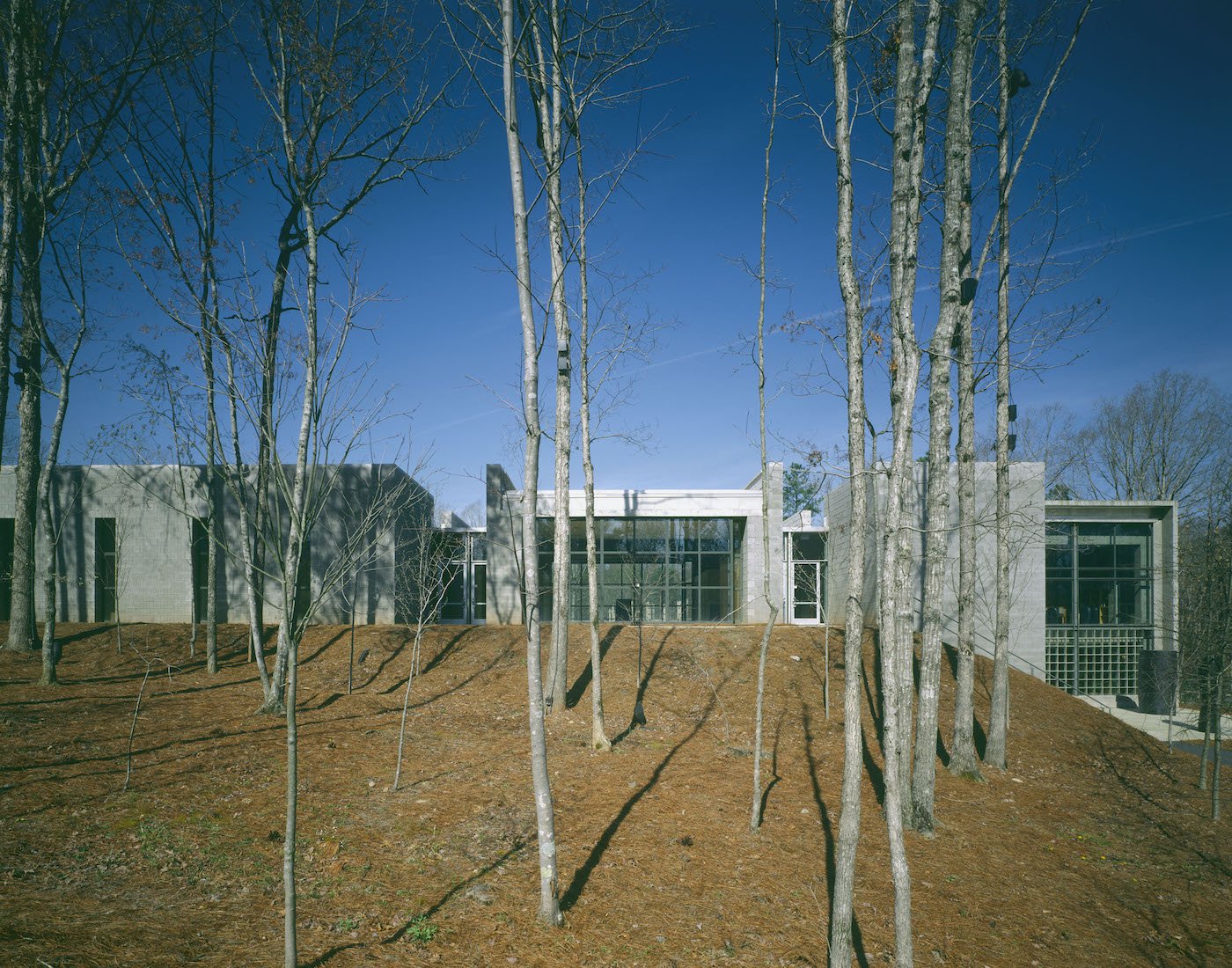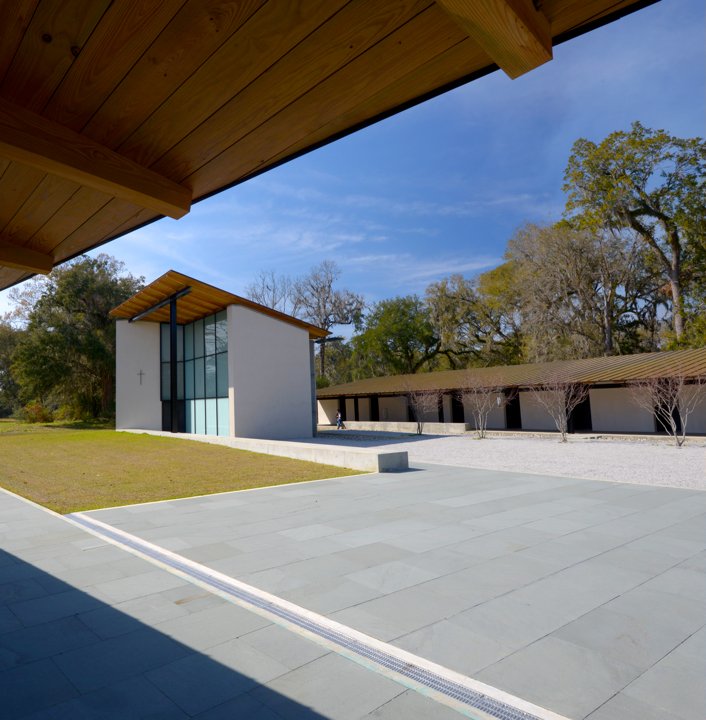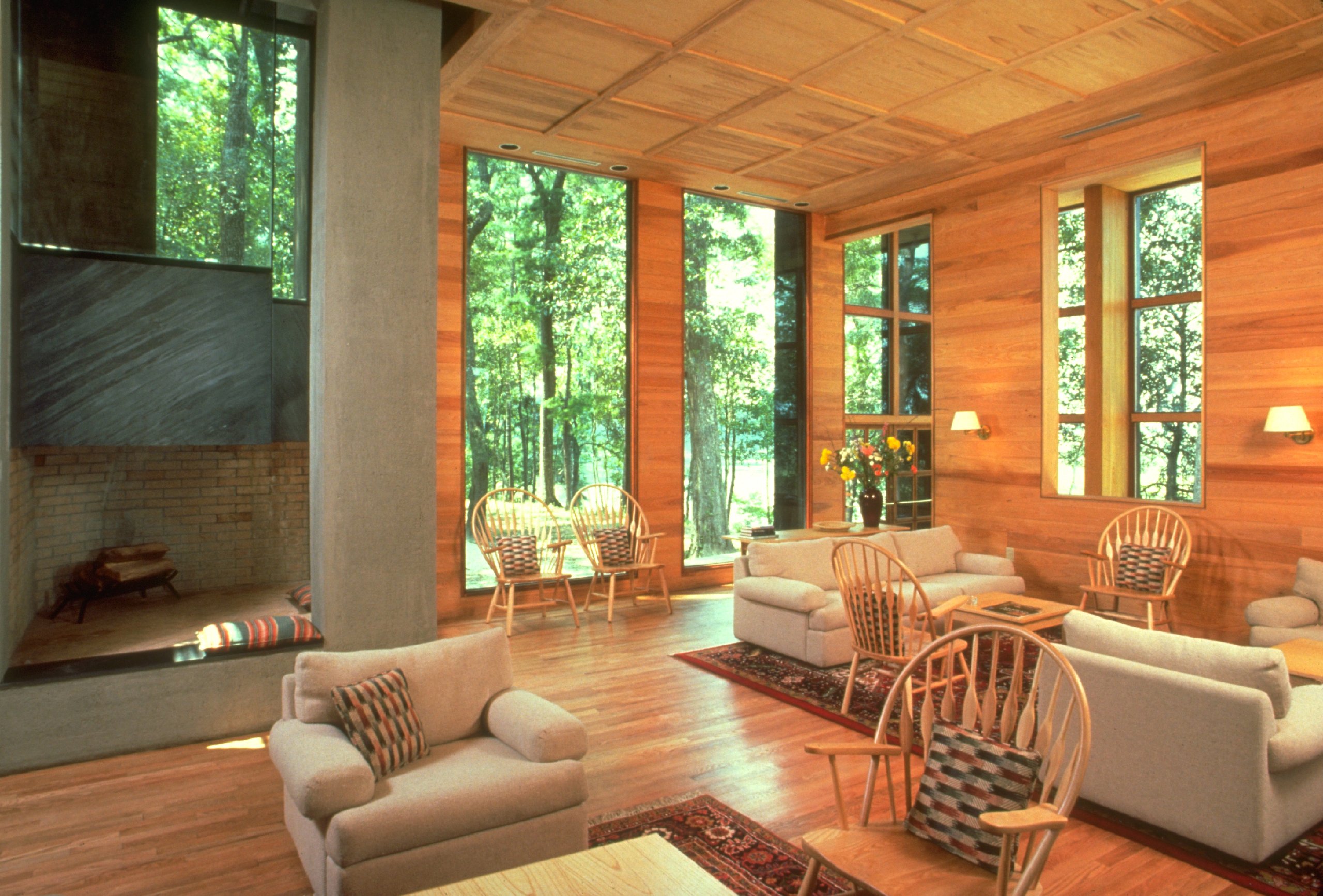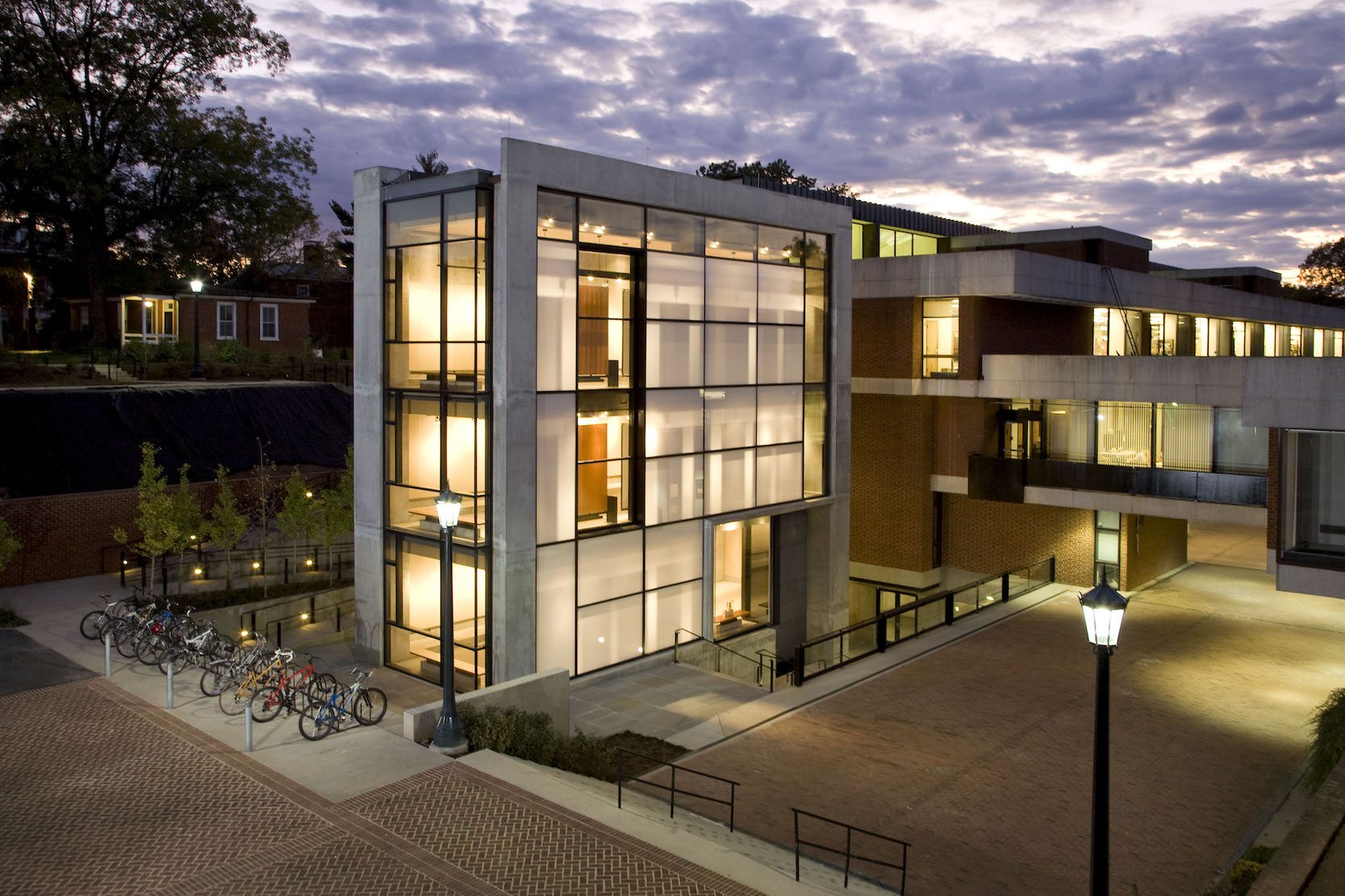
Quality architects are often sure that buildings by anyone else spoil the landscape—see Le Corbusier and Frank Lloyd Wright—but are certain that their own are an improvement. W.G. Clark is a designer of exemplary self-doubt, unsure even if his work is an improvement upon anything, including nature. “I cannot convince myself that settlement, even the most thoughtful, the most beautiful, is better than wilderness,” he wrote in his 1991 essay “Replacement.” He is quick to describe architecture as a “parasitic art” in conversation. He is an atypical architect—and all the better.
A professor of architecture at the University of Virginia, Clark has built only about 20 projects since the late 1970s, almost entirely in South Carolina, North Carolina, and Virginia. His ratio of awards to projects is exceptionally high. The octogenarian has collected numerous AIA awards and won the American Academy of Arts’ Brunner Prize, in 2023, chosen by a jury including Toshiko Mori, Deborah Berke, Steven Holl, Billie Tsien, and Tod Williams. Holl praised the “extraordinary tectonic quality” of Clark’s work, noting that “his architecture, like that of Louis Kahn, is an example of a modernity shaped by historic typology and human scale.” His is a poetic use of extremely demotic materials—very often concrete blocks, the humblest, most plebeian of them all—that generates striking results. His output has been the subject of two books, by Robert McCarter and Richard Jensen, but has earned only intermittent attention otherwise. His last built project was completed more than a decade ago.
Clark has never been in a hurry to build anything, and is deeply skeptical of those who are. He decries sprawl, careless construction, and environmental devastation, and thinks that something has been lost in quantification-heavy efforts to address them. “Everybody has LEED behind their names now and we know what kinds of materials are more sustainable, but it doesn’t seem like the real issues have been touched,” he says. “Policy is being heralded and design is being avoided, as if we were a naval-ship design academy that has gained an enormous interest in the ocean, and lost all interest in boats.” For Clark, having to build in order to fulfill checklists makes it easy to lose track of what sustainability really is—and more damningly, of design altogether.

Born in Louisa, Virginia, in 1942, Clark attended the University of Virginia before heading to Philadelphia, then in its late 1960s golden age. He tried to work for Kahn and Mitchell/Giurgola, but, as he put it, “You don’t hire somebody from the sticks that you’ve never heard of.” He was about to skip town when he received a call from Robert Venturi, which led to about five years of work with him on a number of projects, including the Yale Mathematics Building competition.
Clark noticed that leading architectural lights were drifting out of town, and he did the same, in 1974, although his compass led him in quite a different direction. Charleston, his ultimate destination, was a counterintuitive choice for an avowed Modernist. It was “possibly the most conservative place in the country, but it won my heart,” he says. “The place is beautiful.”
The rootlessness of Modernism has long troubled Clark, who wrestles with the challenge of avoiding revivalism while simultaneously building structures that are authentic to a given place. He found the outline of a very specific housing vernacular in Charleston—tall structures with side porches and elevated social floors, all designed to withstand considerable risks of water, storm, and humidity—and admired it, setting out on a quixotic quest to emulate those qualities.
“I was trying to prove that relationship to place wasn’t something that had passed,” he says. His prompt to himself was “that modern architecture could be generated authentically from a place and become part of it—just as good traditional past architecture has always done.” He built in Charleston for the next 14 years, with Charles Menefee, in a partnership that continued until 1998.
Clark’s first commission of any scale was the Inn at Middleton Place, built on the grounds of a former plantation near Charleston. The owner was a student of Vincent Scully’s at Yale, who clearly taught him a thing or two about quality architecture. In its planning, Clark modestly skipped a more prominent site bordering existing formal gardens, instead choosing the plot of a former phosphate mine off to one side. “Here was an imprint of the past—albeit rape of the earth,” he remembers thinking. “But at least there is history engraved into the site. And I had reason to give it shape.”
Relentlessly concerned with comporting his works with the landscapes, the architect aimed to create “a composite building in which one part was reflective of the earth and became a threshold between the forest and the riverscape, and the other part simply wooden cabinets, attached to this thing.“
It is a remarkable building, a concrete “L” with rooms clustered in wooden pods along one side, involving, as Kenneth Frampton described in his introduction to McCarter’s monograph, a “syntactical play between heavy and light.” There is a mystical air to the concrete, and a homey one to the wood (Clark selected cypress, simply because it smells good), and a magic in their combination.

Most of the remainder of his work has been on homes. His are reliably tall, possibly a stamp of traditional Charleston forms. “I have a propensity for vertical form that plays within the horizontality of the landscape as opposed to engulfing it,” he tells me. This also makes for the least displacement of the landscape possible, a result of his ongoing ambition “to extend the qualities of a place—whatever that is—and to intensify what is there.”
Clark’s approach to building sites is unabashedly reverential. He is not at all hesitant to talk about the spiritual dimension of structure, placing him in very select recent company including Peter Zumthor (the one practicing architect he was willing to praise) and the late Balkrishna Doshi. “Architecture is a disturbing art; it destroys places,” Clark has written. “Building sites always have the scent of sacrifice, barely masked by the hopeful and exciting smell of a new construction. It is our job to assuage the sacrifice and make building an act of understanding and adoration of the place.”
Clark’s palette is radically simple. He recalls a formative trip to Kahn’s Trenton Bath House: “I saw the cheapest materials that America has to offer—the most common asphalt shingles and concrete blocks—and yet there was a nobility in their use. Combine that with a formal plan that Palladio could have done…. It broke my heart.”
The marvel of Clark’s work is not in the materials he uses, but in his virtuosic attention to how and when to combine them—or not. He deems joints “ugly” except when vital, when their very necessity makes their visual case. A railroad trestle is never superfluous.
Other elements do not, and may not, care for being forced together by a brute builder. “People in a crowd do not touch each other unless they absolutely have to,” Clark says. “They avoid it like the plague.” He points to Michelangelo’s The Creation of Adam and the ramp through Le Corbusier’s Carpenter Center for the Visual Arts at Harvard, which touches the larger structure only at its landing, as electric examples of this tension. He incorporates this condition in his own work, leaving thrilling gaps in all sorts of locations. At his Lucy Daniels Foundation and Preschool in Cary, North Carolina, two cinder block columns stand slightly apart, providing a view of the recessed steel structure behind them. It’s mesmerizing.

Clark moved to Charlottesville in 1988, where he began teaching at the University of Virginia School of Architecture, and continued designing. His own house there features a 20-foot-tall, windowless concrete roadside façade, interrupted only by a large void. Glass blocks line the loggia, with a chimney just visible in the back, form an arrangement that is, as he put it, “so abstract that it has no obvious reference.” And yet, he has thought it out. “The chimney is a recompilation of the blocks taken out of the façade and reformed into an object behind it,” Clark says. “The [house’s] whole theme is one of oppositions in contrast.”
He has won other larger commissions, most of which were never built. The two that were—an expansion for the New Orleans Museum of Art and Charelston’s South Carolina Aquarium—deviated so dramatically from his plans that he quit. His other nonresidential projects include a guesthouse for an abbey in South Carolina, and Campbell Hall, an expansion of the School of Architecture at the University of Virginia.
That latter building is another marvel, one that pays exquisite care to a heavily built-up context. The façade is a series of alternating concrete, brick, and glass surfaces that shift on each side, adapting to varying contexts while aping none of them. Clark was intent on not adding another brick building to the campus (“Charlottesville already has more bricks than Rome,” he says), but was determined to add to it thoughtfully.
“The great failure of modern architecture—and I consider myself a modern architect—is that it had no interest in extension or juncture,” Clark says. “It was only interested in new, different, cool.” He was building an extension at the university, but that’s the lesson he continues to impart to his students about all buildings. “When you think about it,” he says, “all architecture is an addition to something.”
Despite plaudits, Clark closed his practice in 2012. He is “itching” to build more. But he continues his steady work of advocating for a different way of building. “A lot of people think of architecture as a service,” he says. “I think of architecture as an art.”
He suggests a different starting point. “Imagine thinking about architecture as connecting ourselves to the place, the environment, the site, the context,” he says. “Imagine architecture as an exponent of an existing place, as a connection to past and future—a continuity not just of a thing, but of a collection of ideas manifested in physical form.” That doesn’t sound too bad.